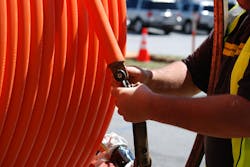How COVID-19 highlighted the cabling industry’s weak spot: Rural broadband
By Dale Willis, Milliken Cable Management
Over the last several months, the cabling industry, along with many others, has experienced the consequences of the COVID-19 pandemic. Industry predictions and expectations have been cast aside as the year of growth that was predicted fell short of that in many areas. While the coronavirus has certainly highlighted areas where the industry can improve, one of the direst is in rural broadband implementation.
With countless workers functioning remotely (an estimated 1.3 billion worldwide), it is no surprise the demand for broadband is soaring this year. Almost every single internet provider has reported a significant uptick in broadband use, as people are using online collaboration tools, video conferencing and virtual private networks (VPNs) to continue working and studying from home. The demand for more bandwidth just keeps growing. But some parts of the country still do not have broadband access at all.Although the industry has known for some time that rural broadband access has been a problem, it hasn’t been quite as urgent as it is now, during a global pandemic. An FCC report from 2018 states over 31% of rural Americans do not have access to broadband at home—a staggering number. And although utilities have helped to close that gap in recent years, the lack of rural broadband access is still an issue.
Government involvement
It's also become clear that the industry can’t close the gap on its own. Fortunately, there’s a lot of legislative energy in Congress currently about the lack of broadband access in rural areas. It’s likely we will soon see some government aid in rural broadband deployment to help grant everyone equal access.
The driving concern regarding rural deployment has always been cost, and government aid is a welcome solution for helping mitigate the deployment overhead. However, the industry must take care that we’re adjusting our installation processes to ensure we aren’t in the same exact situation in 10 or even 5 years as speed requirements increase and 5G is more broadly implemented. As broadband is installed in rural areas, if we don’t take steps to allow for maintenance or upgrades, we will quickly be right back where we started, needing costly upgrades.
Futureproofing
Futureproofing has become vital to many urban installations, with more engineers and installers adjusting for future maintenance and upgrades as underground real estate shrinks. Taking the time to employ these tactics can save installers and owners big on both time and construction costs. Here are just a couple of ways installers can futureproof.
Future pathways: It’s much more cost effective to leave a path for future upgrades during the initial cable installation than to dig twice. Installing two conduits is one option for planning ahead. Another is to install a segmented conduit with dedicated pathways that allow for the placement of more than one cable, like Vis™ Divide. Installing one segmented conduit helps cut installation costs significantly while also providing a future pathway.
Temporary seals: Although it’s possible to access conduits with permanent seals, breaking into them can be costly and time consuming—certainly not ideal for rural areas, where cost is already a factor. Sealing ducts with temporary solutions such as reusable inflatable bags or mechanical plugs helps provide easy, quick access to conduits for any maintenance needs.
The cabling industry needs to be aware of the rural broadband issue and work together to ensure we avoid this problem in the future. By keeping an eye to the horizon and planning now for changes ahead, we can work smarter, not harder, to strengthen rural broadband service.
Dale Willis brings more than 20 years of experience in the building materials, consumer and industrial markets and leads Milliken Cable Management—a business within Milliken & Company that’s leading the data communication network industry with insightful problem solving and future-proofed, cost-effective solutions.

